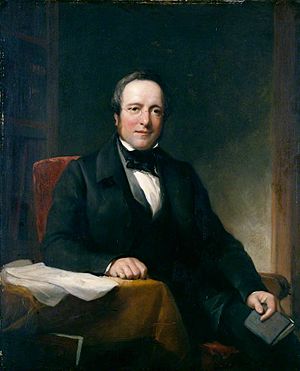Samuel Frederick Gray facts for kids
Samuel Frederick Gray was a British scientist who lived from 1766 to 1828. He studied plants (a botanist), fungi (a mycologist), and medicines (a pharmacologist). His sons, John Edward Gray and George Robert Gray, also became famous scientists who studied animals.
Contents
Early Life and Career
Samuel Frederick Gray's father was a seedsman in London. Samuel first tried to become a doctor, but it did not work out. So, he started writing about medicine and plants instead.
In 1794, he married Elizabeth Forfeit. They moved to Walsall, where he opened an office to test metals. Later, in 1800, he moved back to London. He tried to start a pharmacy business in Wapping, but it did not last long. After that, he earned a living by writing books and giving talks.
Important Medical Books
Gray wrote several important books about medicine and pharmacy.
His book, A Supplement to the Pharmacopoeia, was first published in 1818. A pharmacopoeia is like a guide or a rulebook for making medicines. This book was very popular and had many new versions printed.
In 1819, he became an editor for a magazine called the London Medical Repository. He wrote many articles for it about medicine, plants, and other topics. He also published:
- The Elements of Pharmacy in 1823. This book was a practical guide for pharmacists.
- The Operative Chemist in 1828. This was another useful reference book for people working with chemicals.
Here are some digital versions of his Supplement to the Pharmacopoeia:
- A Supplement to the Pharmacopoeia : being a Treatise on Pharmacology in general. Underwood, London A new and improved Ed. 1821 Digital edition by the University and State Library Düsseldorf
- A Supplement to the Pharmacopoeia : being a Treatise on Pharmacology in general. Underwood, London 3rd Ed. 1824 Digital edition by the University and State Library Düsseldorf
- A Supplement to the Pharmacopoeia, and Treatise on Pharmacology in general. Underwood, London 5th Ed. 1831 Digital edition by the University and State Library Düsseldorf
The Natural Arrangement of British Plants
One of Gray's most famous books today is The Natural Arrangement of British Plants. It came out in two volumes in 1821. There is some debate about who wrote most of it. His son, John Edward Gray, later said he did much of the work.
This book was very new and different for its time. It was the first British book about plants to use a "natural system" for classifying them. This system was developed by Antoine Laurent de Jussieu. It was a better way to group plants than the older "artificial system" used by Carl Linnaeus.
Because it was so different, many traditional botanists did not like it at first. They preferred the older ways.
The book also had large sections about fungi. At that time, fungi were often grouped with "cryptogamic plants" (plants that do not produce seeds or flowers). Gray's book introduced many new groups, or genera, of fungi. Some of these names, like Auriscalpium, Coltricia, Leccinum, and Steccherinum, are still used by scientists today!
Even though it is now seen as very important for naming plants and fungi, many British botanists ignored it for a long time. This was because of its new ideas and different ways of naming things.
See also
- Category:Taxa named by Samuel Frederick Gray


